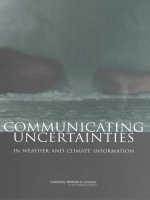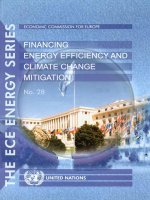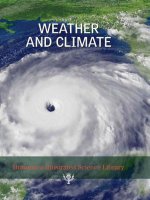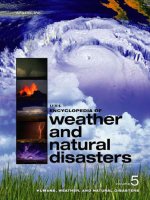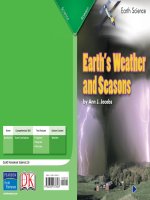Numerical weather and climate prediction
Bạn đang xem bản rút gọn của tài liệu. Xem và tải ngay bản đầy đủ của tài liệu tại đây (7.18 MB, 550 trang )
This page intentionally left blank
Numerical Weather and Climate Prediction
This textbook provides a comprehensive, yet accessible, treatment of weather and climate
prediction, for graduate students, researchers, and professionals. It teaches the strengths,
weaknesses, and best practices for the use of atmospheric models, and is ideal for the
many scientists who use such models across a wide variety of applications. The book
describes different numerical methods, data assimilation, ensemble methods, predictability, land-surface modeling, climate modeling and downscaling, computational fluiddynamics models, experimental designs in model-based research, verification methods,
operational prediction, and special applications such as air-quality modeling and flood
prediction. The book is based on a course that the author has taught for over 30 years at the
Pennsylvania State University and the University of Colorado, Boulder, and also benefits
from his wide practical modeling experience at the US National Center for Atmospheric
Research.
This volume will satisfy everyone who needs to know about atmospheric modeling for
use in research or operations. It is ideal both as a textbook for a course on weather and climate prediction and as a reference text for researchers and professionals from a range of
backgrounds: atmospheric science, meteorology, climatology, environmental science,
geography, and geophysical fluid mechanics/dynamics.
Tom Warner was a Professor in the Department of Meteorology at the Pennsylvania State
University before accepting his current joint appointment with the National Center for
Atmospheric Research and the University of Colorado at Boulder. His career has involved
teaching and research in numerical weather prediction and mesoscale meteorological processes. He has published on these and other subjects in numerous professional journals.
His recent research and teaching has focussed on atmospheric processes, operational
weather prediction, and arid-land meteorology. He is the author of Desert Meteorology
(2004), also published by Cambridge University Press.
“Numerical Weather and Climate Prediction is an excellent book for those who want a
comprehensive introduction to numerical modeling of the atmosphere and Earth system,
whether their interest is in weather forecasting, climate modeling, or many other applications of numerical models. The book is comprehensive, well written, and contains clear
and informative illustrations.”
Dr. Richard A. Anthes, President,
University Corporation for Atmospheric Research, Boulder
“Tom Warner’s book is a rich, effectively written and comprehensive detailed summary of
the field of atmospheric modeling from local to global scales. It should be in the library of
all meteorologists, climate researchers, and other scientists who are interested in the capabilities, strengths and weaknesses of modeling.”
Professor Roger A. Pielke, Sr.,
Department of Atmospheric Science, Colorado State University, Fort Collins
“Tom Warner has taught Numerical Weather and Climate Prediction courses for over thirty
years at Pennsylvania State University and the University of Colorado at Boulder. He also
has been one of the principle developers of numerical models widely used in the atmospheric science community, and has a long history of applying such codes. This extensive
background gives Professor Warner a unique insight into how models work, how to use
them, where their problems lie, and how to explain all of this to students. His book assumes
students have a basic understanding of atmospheric science. It covers all aspects of modeling
one might expect, such as numerical techniques, but also some that might be unexpected
such as ensemble modeling, initialization, and error growth. Today most students have
become model users instead of model developers. Fewer and fewer peer into the models they
use beyond the narrow regions that may directly interest them. With hundreds of thousands
of lines of code, and groups of developers working on individual parts of the code, very few
can say they truly understand all the parts of a model. Professor Warner's textbook should
help both the student and the more advanced user of codes better appreciate and understand
the numerical models that have come to dominate atmospheric science.”
Professor Brian Toon, Chair,
Department of Atmospheric and Oceanic Sciences, University of Colorado, Boulder
“Tom’s new book covers an impressive range of need-to-know material spanning traditional
and cutting-edge atmospheric modeling topics. It should be required reading for all model
users and aspiring model developers, and it will be a required text for my NWP students.”
Professor David R. Stauffer,
Department of Meteorology, The Pennsylvania State University
“The book addresses many practical issues in modern numerical weather prediction. It is
particularly suitable for the students and scientists who use numerical models for their
research and applications. While there have already been a few excellent textbooks that
provide fundamental theory of NWP, this book offers complementary materials, which is
useful for understanding of key components of operational numerical weather forecasting.”
Professor Zhaoxia Pu,
Department of Atmospheric Sciences, University of Utah
Numerical Weather and Climate
Prediction
THOMAS TOMKINS WARNER
National Center for Atmospheric Research, Boulder, Colorado
and
University of Colorado, Boulder
CAMBRIDGE UNIVERSITY PRESS
Cambridge, New York, Melbourne, Madrid, Cape Town, Singapore,
Sa˜o Paulo, Delhi, Dubai, Tokyo, Mexico City
Cambridge University Press
The Edinburgh Building, Cambridge CB2 8RU, UK
Published in the United States of America by Cambridge University Press, New York
www.cambridge.org
Information on this title: www.cambridge.org/9780521513890
©Thomas T. Warner 2011
This publication is in copyright. Subject to statutory exception
and to the provisions of relevant collective licensing agreements,
no reproduction of any part may take place without the written
permission of Cambridge University Press.
First published 2011
Printed in the United Kingdom at the University Press, Cambridge
A catalog record for this publication is available from the British Library
Library of Congress Cataloging-in-Publication data
Warner, Thomas T.
Numerical weather and climate prediction / Thomas T. Warner.
p. cm.
Includes bibliographical references and index.
ISBN 978-0-521-51389-0 (hardback)
1. Weather forecasting – Mathematical models. 2. Climatology – Mathematical models.
QC995.W27 2011
551.63′4 – dc22
2010035492
ISBN 978-0-521-51389-0 Hardback
Cambridge University Press has no responsibility for the persistence or
accuracy of URLs for external or third-party internet websites referred to
in this publication, and does not guarantee that any content on such
websites is, or will remain, accurate or appropriate.
I. Title.
Lewis Fry Richardson is arguably the father of numerical weather prediction.
In addition to his great interest in methods for modeling the atmosphere,
he was equally passionate about developing mathematical equations
that could predict wars, with the hope that they could thus be avoided.
Let us all, in small or large ways, follow LFR’s passions.
With gratitude
to
John Hovermale,
who wanted to write this book
Contents
Preface
Acronyms and abbreviations
Principal symbols
1 Introduction
2 The governing systems of equations
2.1 The basic equations
2.2 Reynolds’ equations: separating unresolved turbulence effects
2.3 Approximations to the equations
3 Numerical solutions to the equations
3.1
3.2
3.3
3.4
3.5
3.6
3.7
3.8
Overview of basic concepts
Numerical frameworks
Finite-difference methods
Effects of the numerical approximations
Lateral-boundary conditions
Upper-boundary conditions
Conservation issues
Practical summary of the process for setting up a model
4 Physical-process parameterizations
4.1
4.2
4.3
4.4
4.5
4.6
4.7
Background
Cloud microphysics parameterizations
Convective parameterizations
Turbulence, or boundary-layer, parameterizations
Radiation parameterizations
Stochastic parameterizations
Cloud-cover, or cloudiness, parameterizations
5 Modeling surface processes
5.1
5.2
5.3
5.4
vii
Background
Land-surface processes that must be modeled
Ocean or lake processes that must be modeled
Modeling surface and subsurface processes over land
page xi
xiii
xviii
1
6
6
7
10
17
17
23
51
58
96
114
116
116
119
119
121
129
140
155
166
166
171
171
172
185
187
Contents
viii
5.5
5.6
5.7
5.8
Modeling surface and subsurface processes over water
Orographic forcing
Urban-canopy modeling
Data sets for the specification of surface properties
6 Model initialization
6.1
6.2
6.3
6.4
6.5
6.6
6.7
6.8
6.9
6.10
6.11
6.12
6.13
Background
Observations used for model initialization
Continuous versus intermittent data-assimilation methods
Model spinup
The statistical framework for data assimilation
Successive-correction methods
Statistical interpolation (optimal interpolation)
Three-dimensional variational analysis
Diabatic-initialization methods
Dynamical balance in the initial conditions
Advanced data-assimilation methods
Hybrid data-assimilation methods
Initialization with idealized conditions
7 Ensemble methods
7.1
7.2
7.3
7.4
7.5
7.6
7.7
7.8
7.9
Background
The ensemble mean and ensemble dispersion
Sources of uncertainty, and the definition of ensemble members
Interpretation and verification of ensemble forecasts
Calibration of ensembles
Time-lagged ensembles
Limited-area, short-range ensemble forecasting
Graphically displaying ensemble-model products
Economic benefits of ensemble predictions
8 Predictability
8.1
8.2
8.3
8.4
8.5
8.6
8.7
Background
Model error and initial-condition error
Land-surface forcing’s impact on predictability
Causes of predictability variations
Special predictability considerations for limited-area and mesoscale models
Predictability and model improvements
The impact of post processing on predictability
9 Verification methods
9.1
9.2
9.3
Background
Some standard metrics used for model verification
More about reference forecasts and their use
192
192
194
196
198
198
199
210
215
216
227
230
231
233
236
242
248
249
252
252
254
257
261
269
271
272
273
280
284
284
284
287
288
290
292
293
294
294
295
299
Contents
ix
9.4
9.5
9.6
9.7
9.8
9.9
9.10
9.11
9.12
9.13
9.14
Truth data sets: observations versus analyses of observations
Special considerations
Verification in terms of probability distribution functions
Verification stratified by weather regime, time of day, and season
Feature-based, event-based, or object-based verification
Verification in terms of the scales of atmospheric features
The use of reforecasts for model verification
Forecast-value-based verification
Choosing appropriate verification metrics
Model-verification toolkits
Observations for model verification
10 Experimental design in model-based research
10.1
10.2
10.3
10.4
10.5
10.6
10.7
10.8
10.9
10.10
Case studies for physical-process analysis
Observing-system simulation experiments
Observing-system experiments
Big-Brother–Little-Brother experiments
Reforecasts
Sensitivity studies
Predictive-skill studies
Simulations with synthetic initial conditions
The use of reduced-dimension and reduced-physics models
Sources of meteorological observational data
11 Techniques for analyzing model output
11.1
11.2
11.3
11.4
11.5
Background
Graphical methods for displaying and interpreting model
output and observations
Mathematical methods for analysis of the structure of
model variable fields
Calculation of derived variables
Analysis of energetics
12 Operational numerical weather prediction
12.1
12.2
12.3
12.4
12.5
12.6
12.7
12.8
Background
Model reliability
Considerations for operational limited-area models
Computational speed
Post processing
Real-time verification
Managing model upgrades and developments
The relative role of models and forecasters
in the forecasting process
300
301
306
307
309
312
317
317
317
318
318
321
321
323
328
329
330
331
338
339
339
340
343
343
343
352
356
356
358
358
360
361
361
362
363
363
364
Contents
x
13 Statistical post processing of model output
13.1
13.2
13.3
13.4
Background
Systematic-error removal
Weather generators
Downscaling methods
14 Coupled special-applications models
14.1
14.2
14.3
14.4
14.5
14.6
14.7
14.8
14.9
14.10
14.11
Background
Wave height
Infectious diseases
River discharge, and floods
Transport, diffusion, and chemical transformations of
gases and particles
Transportation safety and efficiency
Electromagnetic-wave and sound-wave propagation
Wildland-fire probability and behavior
The energy industry
Agriculture
Military applications
15 Computational fluid-dynamics models
15.1
15.2
15.3
15.4
15.5
15.6
Background
Types of CFD models
Scale distinctions between mesoscale models and LES models
Coupling CFD models and mesoscale models
Examples of CFD-model applications
Algorithmic approximations to CFD models
16 Climate modeling and downscaling
16.1
16.2
16.3
16.4
Global climate prediction
Reanalyses of the current global climate
Climate downscaling
Modeling the climate impacts of anthropogenic landscape changes
Appendix Suggested code structure and experiments for a simple
shallow-fluid model
References
Index
366
366
367
375
376
378
378
381
382
386
389
393
394
396
396
399
399
401
401
401
402
403
405
405
407
408
431
432
451
456
461
523
Preface
This textbook provides a general introduction to atmospheric modeling for those using
models for either operational forecasting or research. It is motivated by the fact that all
those who use such models should be aware of their strengths and limitations. Unlike the
many other books that specialize in particular aspects of atmospheric modeling, the aim
here is to offer a general treatment of the subject that can be used for self study or in conjunction with a course on the subject. Even though there is considerable space devoted
here to numerical methods, this is not intended to be the major focus. As the reader will
see, there are many other subjects associated with the modeling process that must be
understood well in order for models to be used effectively for research or operations. For
those who need more information on particular topics, each chapter includes references to
specialized resources. It is assumed that the reader has a Bachelors Degree in atmospheric
sciences, with mathematics through differential equations.
Abbreviations or acronyms, as well as symbols, will be defined in the text the first time
that they appear, and for future reference they are also defined in the lists that appear
before Chapter 1. Even though the student should focus on concepts rather than jargon, a
technical vocabulary is still necessary in order to discuss these subjects. Thus, commonly
used, important terms will appear in italics the first time, in order to identify them as worth
remembering.
There has been no attempt to provide an exhaustive list of references for any particular
topic. The reader should refer to the more-recent references, or one of the review papers
recommended at the end of the chapters, for a thorough list of historical references.
Because World Wide Web addresses tend to change frequently, none are provided here.
Instead, the reader should use an available search engine to access current information
about model specifications or data sources.
Many colleagues provided tangible and moral support during the production of this
book. Cindy Halley-Gotway skillfully and patiently produced the graphic art for the figures and for the cover. Gregory Roux ran model experiments that served as the basis for
plots of shallow-fluid-model solutions, and also generated graphical displays of some of
the functions in Chapter 3. Many individuals shared their time by engaging in very helpful
technical discussions, where special thanks go to George Bryan, Gregory Byrd, Janice
Coen, Joshua Hacker, Yubao Liu, Rebecca Morss, Daran Rife, Dorita Rostkier-Edelstein,
Robert Sharman, Piotr Smolarkiewicz, Wei Wang, and Andrzej Wyszogrodzki. Those who
donated their time and skills by reading and editing chapters include Fei Chen, Luca Della
Monache, Joshua Hacker, Andrea Hahmann, Thomas Hopson, Jason Knievel, Yubao Liu,
Yuwei Liu, Linlin Pan, Daran Rife, Robert Sharman, David Stensrud, Wei Wang, Jeffrey
Weil, and Yongxin Zhang. Christina Brown efficiently managed the process of obtaining
xi
xii
Preface
copyright permissions, and technical assistance with manuscript preparation was provided
by Carol Makowski. Leslie Forehand and Judy Litsey of the library of the National Center
for Atmospheric Research assisted with reference material. And, John Cahir offered useful
comments on the organization of the chapters, which led to a more logical presentation.
Lastly, valuable assistance in many forms was provided by Matt Lloyd, Editor; Laura
Clark, Assistant Editor; and Abigail Jones, Production Editor, of Cambridge University
Press.
Acronyms and abbreviations
3DVAR
4DVAR
AC
AGCM
AGL
ALADIN
AOGCM
AR4
ARPEGE
ARPS
ARW
ASL
BB-LB
BS
BSS
CAM
CAPE
CCA
CCM
CCN
CCSM
CFD
CFL
CFS
CIN
CMAP
CMC
CMIP
COAMPS
COLA
xiii
Three-Dimensional VARiational data assimilation
Four-Dimensional VARiational data assimilation
Anomaly Correlation
Atmospheric General Circulation Model
Above Ground Level
European NWP project
Atmosphere-Ocean General Circulation Model
Assessment Report number 4
Action de Recherche Petite Echelle Grande Echelle (Research Project on
Small and Large Scales)
Advanced Regional Prediction System
Advanced Research WRF model
Above Sea Level
Big-Brother–Little-Brother experiment
Brier Score
Brier Skill Score
Community Atmospheric Model, of NCAR
Convective Available Potential Energy
Canonical Correlation Analysis
Community Climate Model, of NCAR
Cloud Condensation Nucleus
Community Climate System Model
Computational Fluid Dynamics
Courant–Friedrichs–Lewy numerical stability criterion, which requires
that UΔt ⁄ Δx ≤ 1
Climate Forecast System of the US NCEP
Convective INhibition
CPC Merged Analysis of Precipitation
Canadian Meteorological Centre
Climate Model Intercomparison Project
Coupled Ocean–Atmosphere Mesoscale Prediction System,
of the US Navy
Center for Ocean–Land–Atmosphere studies, USA
Acronyms and abbreviations
xiv
CPC
CRMSE
CSI
CSIRO
DCISL
DEMETER
DMO
DNS
DSS
ECHAM
ECMWF
ECPC
EKF
EL
EML
EnKF
ENSO
EOF
ERA
EROS
ESA
ETKF
ETS
F
FAR
FASTEX
FDDA
FFSL
FIM
GABLS
GCM
GEM
GEOS
GFS
GLDAS
GME
Climate Prediction Center
Centered Root-Mean-Square Error
Critical Success Index
Commonwealth Scientific and Industrial Research Organisation, Australia
Departure Cell-Integrated Semi-Lagrangian finite-volume method
Development of a European Multimodel Ensemble system for seasonal to
inTERannual prediction
Direct Model Output
Direct Numerical Simulation
Decision Support System
Global climate model developed by the Max Planck Institute for
meteorology
European Centre for Medium-range Weather Forecasts
Experimental Climate Prediction Center, US Scripps Institution of
Oceanography
Extended Kalman Filter
Equilibrium Level
Elevated Mixed Layer
Ensemble Kalman Filter
El Niño - Southern Oscillation
Empirical Orthogonal Function
ECMWF global reanalysis
Earth Resources Observing System, of the US Geological Survey
European Space Agency
Ensemble Transform Kalman Filter
Equitable Threat Score
False-alarm rate
False-Alarm Ratio
Fronts and Atlantic Storm Tracks EXperiment
Four-Dimensional Data Assimilation
Flux-Form Semi-Lagrangian finite-volume method
Flow-following finite-volume Icosahedral Model, of the US NOAA
Global Energy and Water-cycle EXperiment (GEWEX) Atmospheric
Boundary-Layer Study
General Circulation Model
Global Environmental Multiscale model of the Meteorological Service of
Canada
Goddard Earth Observing System, of NASA
Global Forecasting System, of the US NCEP
Global Land Data Assimilation System, of the US NOAA and NASA
Global model of the German Weather Service
Acronyms and abbreviations
xv
GOES
GPI
GPS
GSS
H
HIRLAM
HRLDAS
HSS
IC
IN
IPCC
IRI
KE
KF
LAM
LBC
LCL
LDAS
LES
LFC
LM
LSM
MADS
MAE
ME
MERRA
MET
MICE
MM4
MODIS
MOS
MRF
MSC
MSE
NAM
NAO
NARR
NASA
NCAR
NCDC
Geostationary Operational Environmental Satellite
GOES Precipitation Index
Global Positioning System
Gilbert Skill Score
Hit rate
HIgh-Resolution Limited Area Model
High-Resolution Land Data Assimilation System, part of the WRF system
Heidke Skill Score
Initial Conditions
Ice Nucleus
Intergovernmental Panel on Climate Change
International Research Institute for Climate and Society
Kinetic Energy
Kalman Filter
Limited-Area Model
Lateral-Boundary Condition
Lifting Condensation Level
Land Data-Assimilation System
Large-Eddy Simulation
Level of Free Convection
Lokal Modell, of the German Weather Service
Land-Surface Model
Model-Assimilated Data Set
Mean Absolute Error
Mean Error
Modern Era Retrospective-analysis for Research and Applications,
of NASA
Model Evaluation Toolkit
Modeling the Impact of Climate Extremes
Penn State University–NCAR Mesoscale Model Version 4
MODerate-resolution Imaging Spectroradiometer
Model Output Statistics
Medium-Range Forecast model, of the US NWS
Meteorological Service of Canada
Mean-Square Error
North American mesoscale Model, of the US NCEP
North Atlantic Oscillation
North American Regional Reanalysis
National Aeronautics and Space Administration, of the USA
National Center for Atmospheric Research, of the USA
National Climatic Data Center, of NOAA
Acronyms and abbreviations
xvi
NCEP
NESDIS
NetCDF
NMC
NNMI
NNRP
NOAA
NOGAPS
NSIP
NWP
NWS
OI
OLAM
OLR
OMEGA
OSE
OSSE
PC
PCA
PCMDI
PILPS
POD
PP
PRUDENCE
PV
QA
QC
QPF
RAMS
RANS
RASS
RCM
RFE
RH
RMS
RMSE
ROC
RPS
National Centers for Environmental Prediction, of NOAA
National Environmental Satellite, Data, and Information Service, of
NOAA
Network Common Data Format
National Meteorological Center, predecessor of NCEP
Nonlinear Normal-Mode Initialization
NCEP-NCAR Reanalysis Project
National Oceanic and Atmospheric Administration, of the USA
Navy Operational Global Atmospheric Prediction System, of the USA
NASA Seasonal-Interannual Prediction Project
Numerical Weather Prediction
National Weather Service, of the USA
Optimal Interpolation
Ocean–Land–Atmosphere Model
Outgoing Longwave Radiation
Operational Multiscale Environment Model with Grid Adaptivity
Observing-System Experiment, Observation Sensitivity Experiment
Observing-System Simulation Experiment
Proportion Correct
Principal Component Analysis
Program for Climate Model Diagnosis and Intercomparison
Probability Distribution (or Density) Function
Project for Intercomparison of Land-surface Parameterization Schemes
Probability Of Detection
Perfect-Prognosis
Prediction of Regional scenarios and Uncertainties for Defining
EuropeaN Climate change risks and Effects
Potential Vorticity
Quality Assurance
Quality Control
Quantitative Precipitation Forecast
Regional Atmospheric Modeling System, of Colorado State University
Reynolds-Averaged Navier–Stokes equations
Radio Acoustic Sounding System
Regional Climate Model
Regional Finite Element model, of Canada
Relative Humidity
Root-Mean-Square, error or difference
Root-Mean-Square Error
Relative Operating Characteristic
Rank Probability Score
Acronyms and abbreviations
xvii
RPSS
RSM
RTG
RUC
RUC-2
SC
SCIPUFF
SEVIRI
SFS
SGMIP
SL
SLP
SNOTEL
SOM
SREF
SS
SSM/I
SST
STARDEX
STATSGO
SVD
TKE
TOMS
TRMM
TS
UCM
UKMO
UMOS
WRF
WSR-88D
Rank Probability Skill Score
Regional Spectral Model, of NCEP
Real-Time Global analysis, of the Marine Modeling and Analysis Branch
of NCEP
Rapid Update Cycle model, of the US NCEP
RUC, version 2
Successive Correction
Second-order Closure Integrated PUFF model
Spinning Enhanced Visible and InfraRed Imager
SubFilter Scale
Stretched-Grid Model Intercomparison Project
Starting Level
Sea-Level Pressure
SNOw TELemetry
Self-Organizing Map
Short-Range Ensemble Forecasting
Skill Score
Special Sensor Microwave Imager
Sea-Surface Temperature
STAtistical and Regional dynamical Downscaling of EXtremes
State Soil Geographic data base
Singular Value Decomposition
Turbulent Kinetic Energy
Total Ozone Mapping Spectrometer
Tropical Rainfall Measurement Mission satellite
Threat Score
Urban Canopy Model
United Kingdom Meteorological Office
Updatable MOS
Weather Research and Forecasting model
Weather Service Radar, 1988, Doppler
Principal symbols
Roman capital letters
A
B
B
C
CG
CP
CR
D
DΘ
E
ET
F
Frx
G
H
H
HS
I
I↓
I↑
J
K
xviii
covariance matrix of the analysis errors
Planck’s function
background covariance matrix
phase speed
cloud fraction
thermal capacity, or heat capacity
economic cost of protecting against a weather event
group speed
phase speed
real part of a phase speed
rate of water loss through drainage within the substrate
soil-water diffusivity
evaporation rate
evapotranspiration rate
all terms on the right side of a prognostic equation
flux
frictional acceleration in the x direction
sensible heat flux between the surface and subsurface
rate of gain or loss of heat
sensible heat flux between the surface and the atmosphere
mean depth of a fluid
scale height
forward operator, observation operator
heat flux within the substrate
longwave radiation intensity
downward-directed longwave radiation intensity
upward-directed longwave radiation intensity
cost function
highest permitted wavenumber
transfer coefficient
Principal symbols
xix
K
KΘ
KHs
L
LR
M
P
P
Q
Qv
Q
R
R
RH
S
T
Ta
Tg
Ts
U
V
V
VT
X
Kalman gain matrix
Weight matrix of analysis
hydraulic conductivity
thermal diffusivity of a substrate
domain length
latent heat of evaporation
horizontal length scale
economic loss from a weather event
length scale of the Rossby radius of deformation
model dynamic operator
wave period
rate of water input through precipitation
error covariance matrix
direct-solar radiation intensity
rates of gain or loss of water vapor through phase changes
covariance matrix of the model forecast errors
rhomboidal truncation
gas constant for air
Rossby radius of deformation
net-radiation intensity
rate of water loss through surface runoff
radius of influence
covariance matrix of the observation errors
relative humidity
source or sink of water substance
temperature
turbulent, eddy, or Reynolds’ stress
triangular truncation
atmospheric temperature a short distance above the surface
temperature of the ground surface
temperature within the substrate
mean wind speed
value, economic value
velocity vector
terminal velocity
vector of atmospheric state variables
Roman small letters
a
c
radius of Earth
specific heat
Principal symbols
xx
cp
e
f
g
h
i
k
ks
l
m
n
o
p
ps
pt
q
qs
r
t
u
u*
v
w
x
x
y
y
z
zo
specific heat at constant pressure
Coriolis parameter
base of natural logarithms
Coriolis parameter
generic dependent variable
acceleration of gravity
depth of a fluid
–1
wavenumber
kinetic energy
von Karman constant
weighting coefficient in statistical analysis
soil thermal conductivity
length scale of energy-containing turbulence
map-scale factor
integer wavenumber
integer wavenumber
observation
pressure
probability
pressure at the land or water surface
pressure at the top of a model
specific humidity
diffuse solar radiation
saturation specific humidity
radius of Earth
radial distance
time
east–west component of wind
friction velocity
north–south component of wind
vertical component of wind
east–west space coordinate
general space coordinate
state vector
north–south space coordinate
observation vector
vertical space coordinate – distance above or
below surface of substrate
roughness length
Principal symbols
xxi
Greek capital letters
Δ
Δx
Θ
Ω
change or difference in some quantity, operator
spatial filter length scale
grid increment
volumetric soil-moisture content
rotational frequency of Earth
Greek small letters
α
γ
γd
δ
ε
θ
λ
μ
π
ρ
σ
τ
φ
ω
albedo
generic dependent variable
vertical lapse rate of temperature
dry adiabatic lapse rate of temperature
Kronecker delta
alternating unit tensor
emissivity
error
potential temperature
longitude
amplification factor
wavelength
dynamic viscosity coefficient
thermal admittance
pi
density
Stefan–Boltzmann constant
terrain-following vertical coordinate
standard deviation
momentum stress, or shearing stress
relaxation coefficient
latitude
frequency of a wave
Common subscripts and superscripts
E
G
I
applies on Earth’s surface
applies on a grid
imaginary part of a number
Principal symbols
xxii
R
T
a
b
g
i
j
k
m
o
p
s
τ
real part of a variable
transpose
analysis
atmosphere
background
ground or substrate surface
grid-point index in x direction
grid-point index in y direction
grid-point index in z direction
wavenumber
observation
wavenumber
applies at constant pressure
saturation
surface
substrate or soil
point on the discrete time axis
Introduction
1
When Phillip Thompson began to write the first widely read textbook1 on numerical
weather prediction2 (NWP), the subject was in its infancy, even though an earlier book,
Weather Prediction by Numerical Process by L. F. Richardson (1922), presaged what
was to come later in the century after the advent of electronic computers. The availability of computers increased greatly in the 1960s, and universities began to offer courses
in atmospheric modeling, but most modelers had to also be model developers because
the untested codes had many errors, the numerical schemes for solving the equations
and the physical-process representations were not well tested and understood, lateralboundary conditions for limited-area models produced noisy solutions, and codes for
defining the initial conditions needed to be further developed. These early practitioners
learned the basics of atmospheric modeling from each other, through journal articles, in
seminars and conferences, and from early courses on the subject. During the last
30 years of the twentieth century, graduate-level courses in atmospheric modeling flourished at many universities. And because computer modeling of the atmosphere was
increasingly becoming an important tool in research and operational weather prediction,
these courses were typically filled. Nevertheless, atmospheric modeling was still somewhat of a specialty, and models were not very accessible beyond national centers and a
few research universities. Smagorinsky (1983), Thompson (1983), Shuman (1989),
Persson (2005), Lynch (2007), and Harper (2008) should be consulted for additional history on atmospheric modeling.
In contrast, most of today’s modelers are model users only, not developers, and have
available, at no cost, well-tested community, global and limited-area models with complete documentation, regular tutorials, and help desks. Some models are being touted as
“turn-key” systems that can be run on desk-top computers, and they are accessible to anyone in the meteorological and nonmeteorological communities having little experience in
atmospheric modeling and knowledge of the model limitations. There are, of course, still
the developers working on the next-generation in modeling capabilities, but they are distinct from the much-more-numerous model users who simply want to employ the model as
1
2
1
Thompson (1961)
Historically the expression “numerical weather prediction” has been used to describe all activities involving the numerical simulation of atmospheric processes, whether or not the models were being used for
research or operational forecasting. But, some reserve the use of this reference only for model applications
to forecasting. In this book we will use the term “numerical weather prediction” to refer to all types of
model uses.
